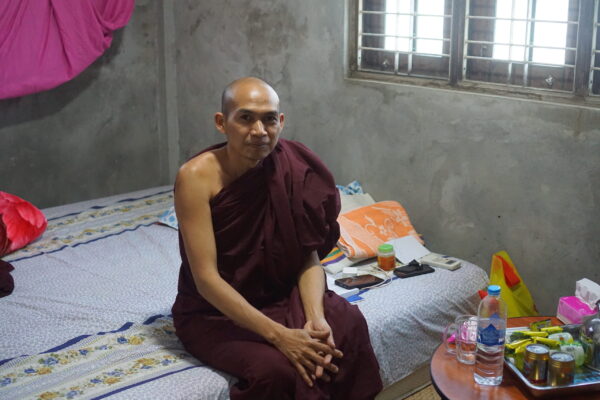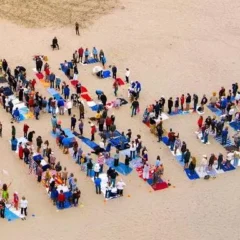I visited Yangon for the first time in January 2020, and from the airport tarmac into its downtown, the city had been signposted with billboards of Aung Sang Suu Kyi’s face. She was being tried by the International Court of Justice that winter, for her role in alleged crimes against humanity committed against the Rohingya, a Muslim minority group. The billboards were part of the massive show of support from the Burmese people, whose love for Suu Kyi has redoubled as her international critics have become more harsh.
Nobel laureate Suu Kyi is likely the most famous Burmese person in the world, and was once an “exemplar” – the best of her kind – in her own right, of peaceful protest, and for standing up for democracy against unthinkable odds. But outside Myanmar today, her reputation has been darkened considerably by what many see as either tacit permission of, or active support for, the ethnic cleansing of Rohingya Muslims, who have been the victims of a brutal military campaign of killing and displacement, especially since 2017.
It was a curious time to pursue my own project, for CRCC, of interviewing “exemplary” spiritual and religious leaders around the world. Among the many lessons of Myanmar’s trajectory in recent years is the folly of projecting too much on a single exemplary individual.
As a Southeast Asia-based foreign correspondent, I had long nursed a curiosity about visiting and reporting from Myanmar. When I first moved to Indonesia in late 2016, the Rohingya crisis was rapidly escalating in scale, and the refugee crisis at the Bangladesh border was developing into one of the region’s biggest news stories. And Suu Kyi’s reputation was just beginning to turn a corner in public discourse. It sometimes seemed like every other journalist and aid worker I met in Jakarta had once worked in Myanmar, and in their recounting of their time there, they impressed upon me the quantities of red tape, surveillance and general difficulty in finding out any information at all, especially when it came to the Rohingya issue.
It was enough to discourage my visit, as a bootstrapped independent journalist, for some time. But the support of the Spiritual Exemplars project finally provided an opening. I think the timing worked out just right.
When I finally went, I had developed a solid understanding of what I think of as “comparative fundamentalisms,” having reported on Buddhist nationalism in Thailand, Hindu nationalism in India, Islamic nationalism in Indonesia, and (unfortunately) much more. I looked forward to researching the nuances of Buddhist nationalism in Myanmar from that comparative framework, rather than from a blank slate, or from the position of righteous innocence often adopted by Western journalists abroad.
I also had a significant, albeit poorly detailed, familial connection to the place. My paternal grandfather, Venkatraman, was born in Yangon (then Rangoon) in 1925. He started his life as a subject of the British Raj and died in independent India, before I was born. I never got to ask him about the circumstances of his migration, in the wake of several nativist, anti-Indian race riots in colonial Burma, which sent many people of Indian descent fleeing on foot and tenuous ground transport back to the subcontinent. In his case, it was back to Vellore, a small city in Tamil Nadu, and onward to a Dickensian adolescence in a Ramakrishna Mission, where he worked gruelling hours of manual labor to get a secondary education that his family could not otherwise provide.
I wish I could say visiting Yangon gave me some great insight into my grandfather’s life, but it remains a tough nut to crack. He left no papers behind and seems never to have spoken about the dark episode to his own children, so pending some serious oral history research with the extant nonagenarians of that period in Myanmar and Tamil Nadu, I doubt any breakthroughs are forthcoming.
At the turn of the century, nearly half of Rangoon was populated by people of Indian descent, but their numbers plummeted after that 1930s emigration. Still, and to my surprise, even in 2020, there were far more Indians, especially Tamils, in modern-day Yangon than I expected, and quite a lot of Tamil-lettered storefronts, and many friendly faces who struck up conversation with me. The majority of Tamils who remain in Myanmar are Hindu, like my grandfather was; they are by no means persecuted like many Burmese Muslims are today, but nevertheless, as a non-Buddhist minority, they remain the focus of some identitarian, nationalist friction.
When I had a spare afternoon between interviews, I bee-lined to the tomb of the last Mughal emperor, the tragic and decadent Bahadur Shah Zafar, who is also buried in Yangon, in a pretty mosque that still sees brisk foot traffic. I bring these episodes up just as a few examples of the deep multicultural roots of a place that’s now trying to define itself, like so many places in the world today, as comprising one people and one faith.
Not that all Burmese Buddhists share that vision. The main person I had come to see in Yangon was Ashin Issariya, a.k.a. King Zero, a singular monk and democracy activist who had spent years in exile in Thailand, but who now uses his platform to speak out against the virulent strain of Buddhist nationalism that has taken hold of Myanmar in recent years. He travels frequently and was an elusive target for months, but the dry season of traveling sermons brought him to Yangon and provided me a brief window of opportunity.
As a journalist, I often weigh two competing impulses: to find the character who distills a spirit of their time and moves a story along, and to be deeply skeptical of any single story, especially in the fraught enterprise of foreign correspondence, where outside context for readers can be thin. Issariya’s story was incredible, and I was impressed by his unique combination of serene spirituality and daredevil bravery. He spoke fluently about the practical applications of abstract Buddhist philosophical concepts like “loving-kindness,” and without drama about the online abuse he faces from intolerant members of the monkhood and nationalist lay followers. He also articulated the demand for religious tolerance in a decidedly religious, in-group vernacular, which is a distinct line of argument from Western critiques based on notions of liberalism, secularism and pluralism. (I happen to think both have their uses, but that there is a preponderance of attention to the latter in media critiques.) The facts of his life were poetic: He was a superstar monk who drew massive crowds and spoke to them extemporaneously for hours, but he lived in utmost simplicity, carrying just a small bag of possessions during his peregrinations, lodging with ordinary families and eating humble, donated meals of rice and fish.
But as impressed as I was with Issariya’s charisma and his irresistible life story, I took care, in the following days, to seek out other monks, like Mandalay-based U Seindita, who shared his sympathies, and to bracket the story that I later wrote about him with plenty of explanatory material. The fact is, Issariya represented a minority voice of opposition within the Burmese sangha, its class of monks and clerics. And while I was privileged to hear his story, it would do no one any favors to exaggerate the significance of this individual. The article I wrote came to be subtitled, “What Comes After Militant Buddhism?” If the resistance comes from the clerical establishment, as I have posited, it will be due to the efforts of many, not few.
Krithika Varagur is a journalist fellow with the Spiritual Exemplars Project.







